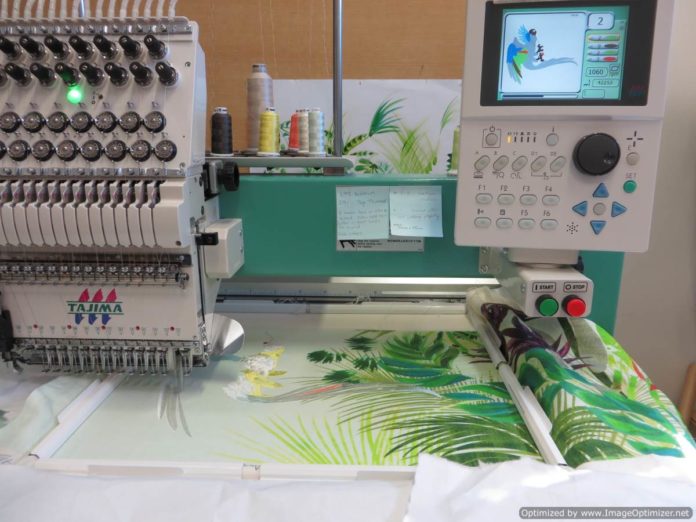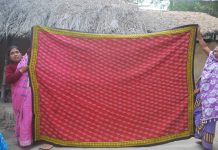Textile practitioners in Aotearoa New Zealand draw upon a range of cultural traditions—indigenous, introduced and culturally cross-pollinated.
Māori weaving
Māori weaving, as other forms of specialist ancestral art, embodies cultural knowledge, values and skills. Among the diverse natural resources utilised by Māori, harakeke (Phormium tenax) is indispensable. Harakeke is harvested to make kete (baskets), whaariki (fine floor mats) and piupiu (waist garments), among other items. The silky inner fibre of the harakeke leaf, called muka, or whitau, is extracted and processed to produce hundreds of hand spun threads. The muka threads are intertwined by hand using the whatu technique, to create the textile foundation of traditional garments.

Māori weaving underwent a revival in the mid-to-late twentieth century. The practice is supported by Te Roopu Raranga Whatu o Aotearoa (National Collective of Māori Weavers in New Zealand), whose mission is “to nurture, develop and preserve the techniques and tikanga (custom) of raranga (plaiting), whatu (finger weaving) and tāniko (weft-twined patterning technique) in traditional and modern contexts for Māori weavers”. Weaving skills are passed down through whanau (families) and can also be formally studied at institutions such as Te Rito (The National Weaving School) in Rotorua or at tikanga Māori education providers such as Te Wānanga o Aotearoa, Te Whare Wānanga o Awanuiārangi and Te Wānanga o Raukawa.
Contemporary Māori weavers use a wide range of materials, from natural fibres to copper wire and plastics. Their work can be seen in a myriad of contexts from ceremonial occasions, to the art gallery and catwalk.
Western traditions
Pākehā (European) traditions of weaving, knitting, patchwork, quilting and embroidery are practiced across the country at a professional and grassroots level. These craft forms are supported by national membership groups such as Aotearoa Quilters, the Association of New Zealand Embroiderers Guilds (ANZEG), the Professional Weavers Network, Fibre Arts New Zealand, and Creative Fibre (formerly the NZ Spinning, Weaving and Woolcrafts Society). The latter brings together spinners, weavers, knitters, dyers, flax workers, felters, crocheters and “free form” fibre artists, and has a membership of over 3000 makers. As a wool producing nation, wool remains a popular and versatile material. These organisations run active programmes of workshops, exhibitions and symposia, and publish journals and magazines such as Threads (ANZEG).
Weave, knit, embroidery, dye and print are taught at a tertiary institutions, including AUT (Auckland), Massey University (Wellington), and the Nelson Marlborough Institute of Technology, as part of design and art degrees. These programmes place an emphasis on innovation and the exploration of new materials and technologies, and offer students and practitioners opportunities to extend their practices via access to specialist research laboratories such as AUT’s Textile & Design Lab and Massey University’s FabLab.
Traditions from across the Pacific
Migrants from Pacific Island nations, such as the Cook Islands, Niue and Tonga, have also introduced a range of textile practices to New Zealand. Harakeke, raffia ribbon and plastics have come to replace traditional weaving materials, for example pandanus, which are not readily available in New Zealand. These fibres are used for weaving mats, hats, baskets, fans, body adornments and performance costumes. Some items, such as pandanus fine mats or tapa cloth are imported from the islands, and then embellished locally, for example Fala pati (Tongan embroidered mat). Tivaevae making has also been introduced to New Zealand from the Cook Islands.
Textile traditions from the across the Pacific are kept alive in New Zealand by church and community groups such as the Pacific Mamas and Papas who established the Pacific Arts Centre in Henderson, Auckland, the world’s largest Polynesian city. Annual Pasifika festivals in both Auckland and Wellington provide a public showcase for their work. The Auckland War Memorial Museum and Te Papa in Wellington hold the largest collections of Maori and Pacific textiles, both historic and contemporary, in New Zealand.
On show
Whereas Maori weaving has gained a high profile in New Zealand, many textile practitioners struggle to gain visibility within the country’s public gallery system. As a result a number of textile practitioners focus their energy on exhibiting internationally in Australia, Europe and North America. Visitors to New Zealand are advised to look at the above organisations’ websites for information regarding exhibitions, events and open studios. Members of the Professional Weavers Network, for example, welcome studio visits by appointment, and a number of tours are available in the Nelson area, a region well known for its textile practitioners.
Since the late 1980s, competitions such as World of Wearable Art™ (1987-), Hokonui Fashion Awards (1988-), Style Pasifika (1994-2011), Cult Couture (2001-) and WoolOn™ Creative Fashion Event (2003-), all of which feature stage shows, have provided a showcase for practitioners creating textiles for the body. The World of Wearable Art™ Museum in Nelson also collects and exhibits wearable art.
Further reading
Ann Packer, Stitch: Textile Art in New Zealand, Random House, 2006
Lynnsay Rongokea, The Art of Tivaevae: Traditional Cook Islands Quilting, Random House New Zealand, Auckland, 2001
Awhina Tamarapa (ed), Whatu Kākahu: Māori Cloaks, Te Papa Press, Wellington, 2011





